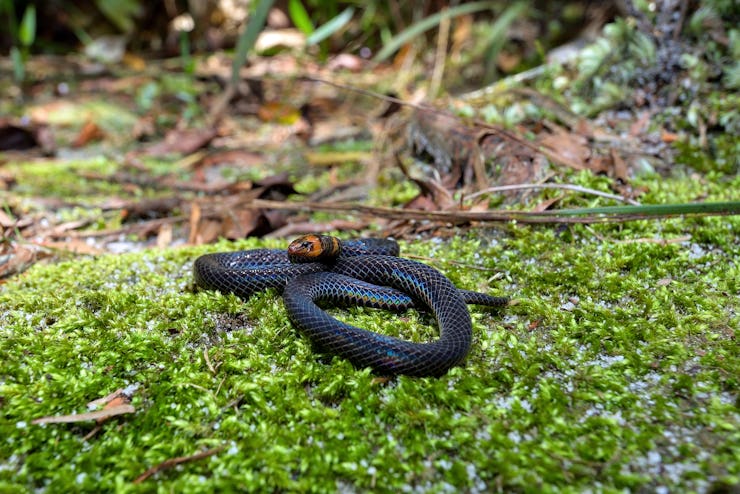Watch: Researchers Catch Tiny Snake in the Act of Cartwheeling
Meet the first known snake that can flip like a gymnast.

You wouldn’t want to come face to face with a hoop snake. A staple in North American and Australian folklore since colonial times, these creatures were said to hold their tails in their mouths and roll after prey. The last thing you’d see is a scaly wheel flying at you before being struck by a venomous stinger.
While the hoop snake is more legend than reality, researchers recently documented that some wild snakes do know how to roll. However, that motion looks a lot more like a floppy cartwheel, and doesn’t involve biting tails or whipping out a stinger.
A study published Wednesday in the journal Biotropica notes the first recorded examples of cartwheeling in any snake species. Researchers documented two separate occasions where the Dwarf Reed Snake launched itself into an acrobatic series of flips.
Anecdotal reports of the tiny, cartwheeling snakes have long been known to researchers, but it wasn’t until 2019 that herpetologist Evan Seng Huat Quah was able to capture images of the snake rapidly twisting its body as it tried to cross a road on Mount Jerai in the state of Kedah, Malaysia.
Quah, a professor at Universiti Malaysia Sabah, is an author of the new study and included the photos in the report:
This series of photos shows the Dwarf Reed Snake cartwheeling in midair.
The researchers also noted that a video posted to YouTube in 2022 captured the same behavior on tape. Campers in Lenggong, Malaysia filmed another Dwarf Reed Snake making a rapid escape after being poked at with a stick.
Skip ahead to about 1:51 in the video to see the snake roll.
It’s likely that the flipping behavior is a defense mechanism, since Dwarf Reed Snakes are small and sometimes preyed upon by larger snakes.
Gravity seems to give the acrobatic snakes an escape advantage. When rolling down an incline, they can gain more momentum and tumble away faster, which the researchers observed in the one snake they saw on Mount Jerai.
The element of surprise could also be a benefit to rolling rather than slithering, since such a sudden airborne movement could startle predators. And if a larger snake was following its nose to find a meal, it’d be more difficult to track the patchy scent trail left behind by a cartwheeling snake.
These impressive acrobatics remain an extremely rare behavior in the animal kingdom. Some invertebrates, like desert spiders and moth caterpillars, are known to roll or tumble in similar ways. So are a few vertebrates, like tepui toads and the Mount Lyell Salamander.
Since tumbling was observed so clearly in Dwarf Reed Snakes, that leaves researchers wondering about other snake species. Is it possible that there are more small snakes that can cartwheel too, even if scientists haven’t been able to record it yet?
“We believe that this behavior may be more widespread in other small snake species, especially members of the subfamily Calamariinae,” Quah said in a statement. “But the lack of records is probably an artifact of the challenges in detecting and observing these secretive species.”